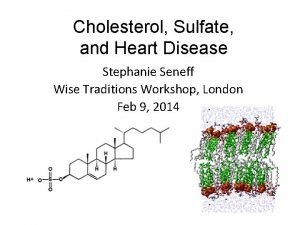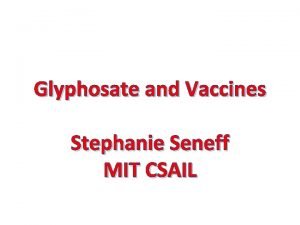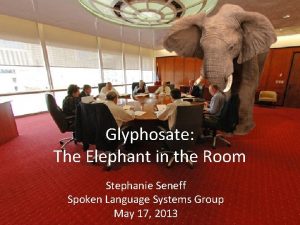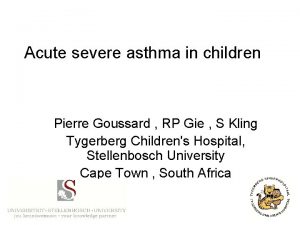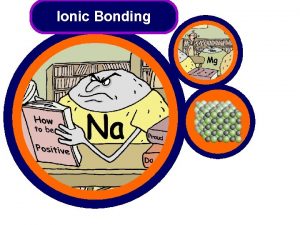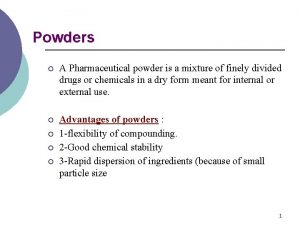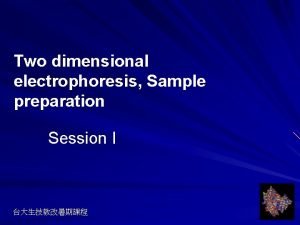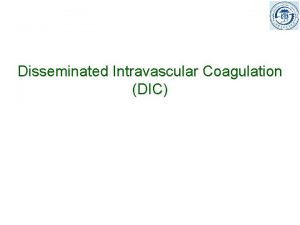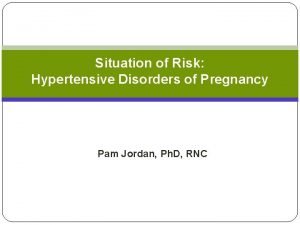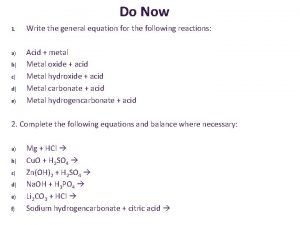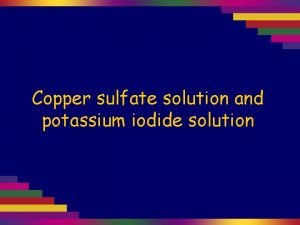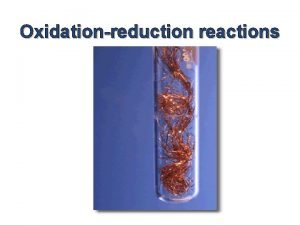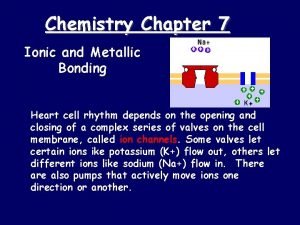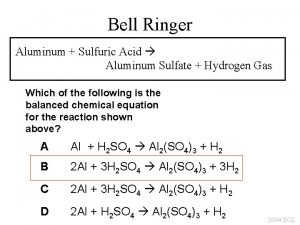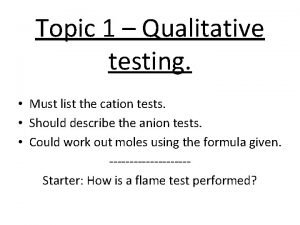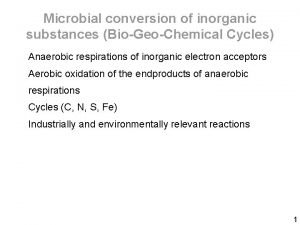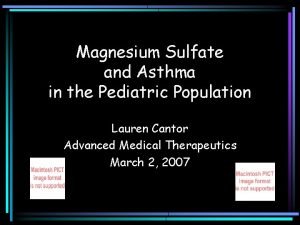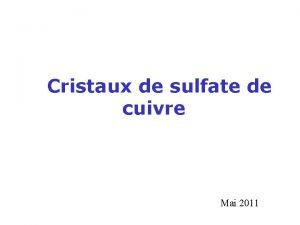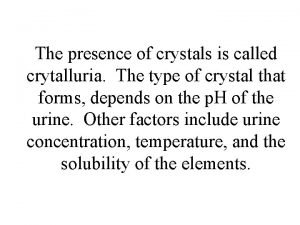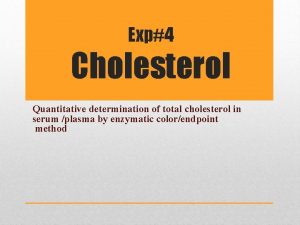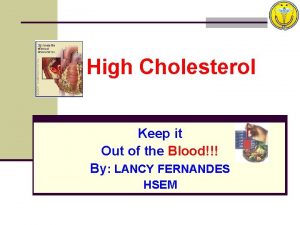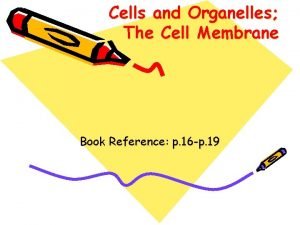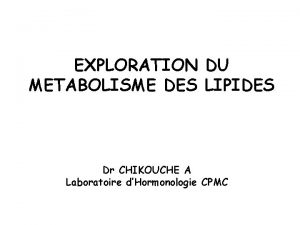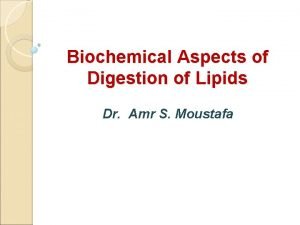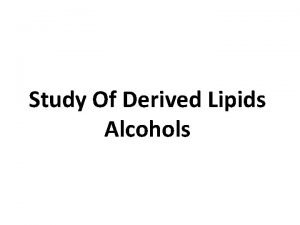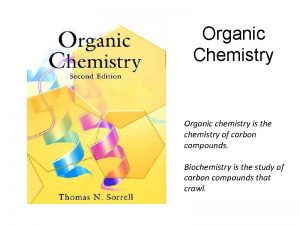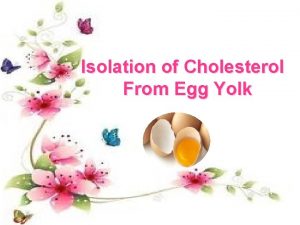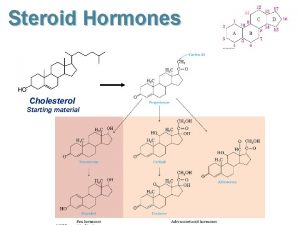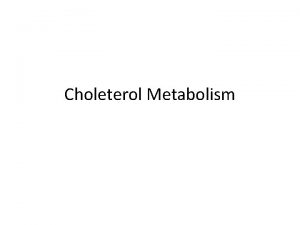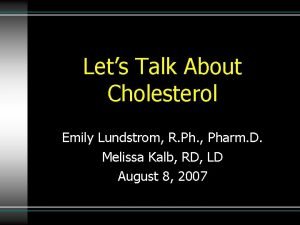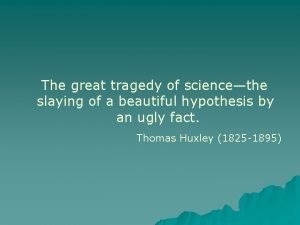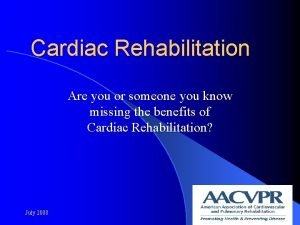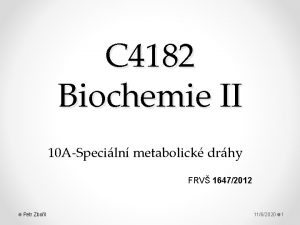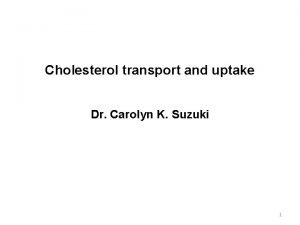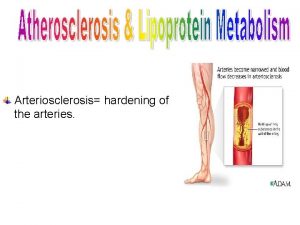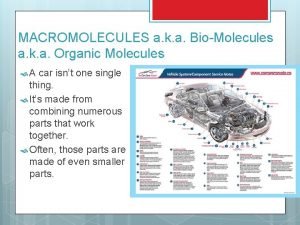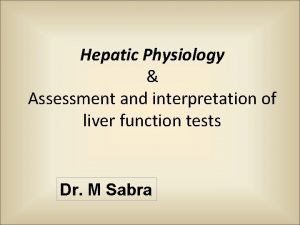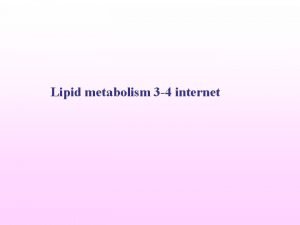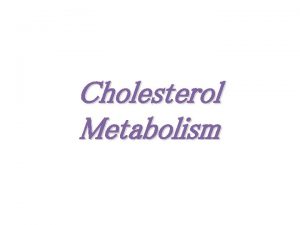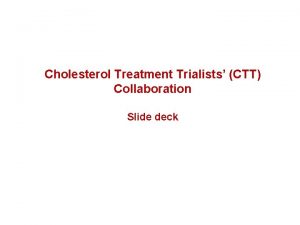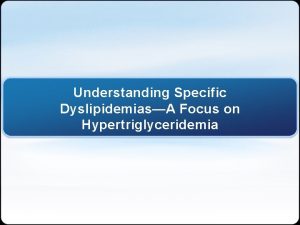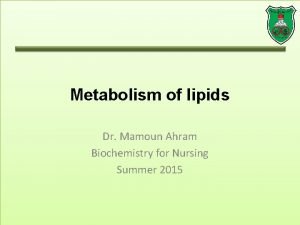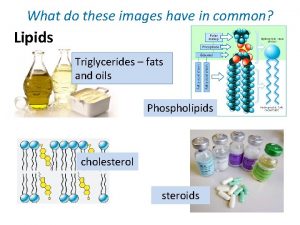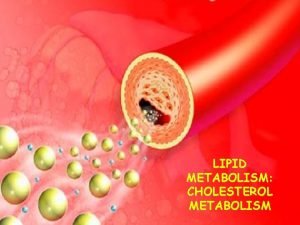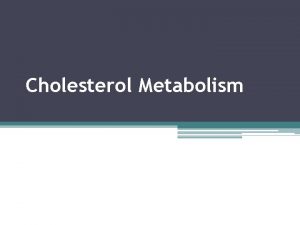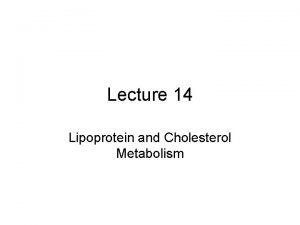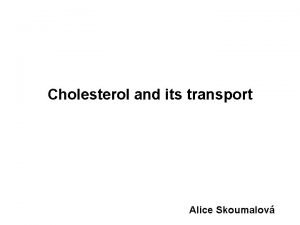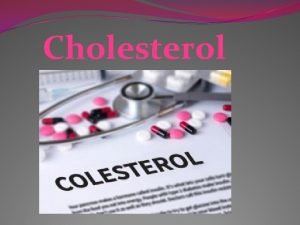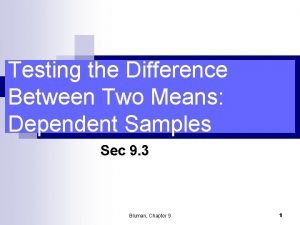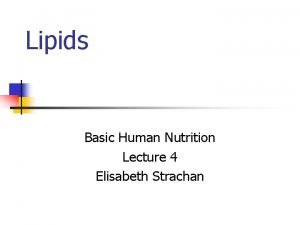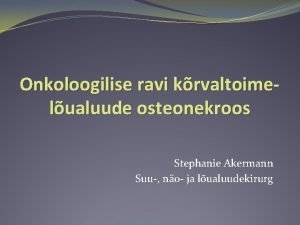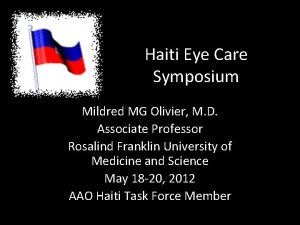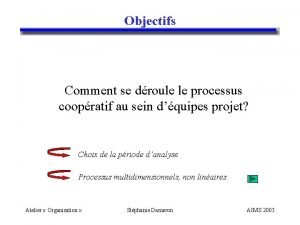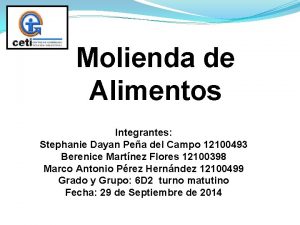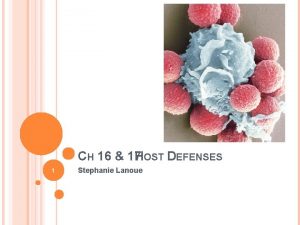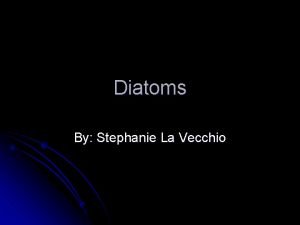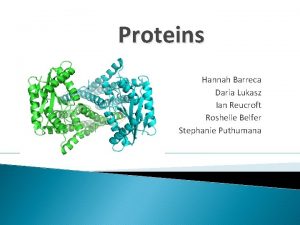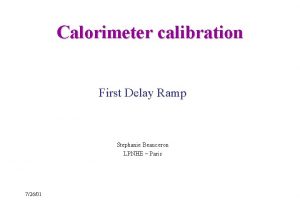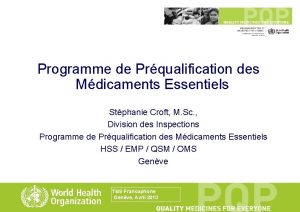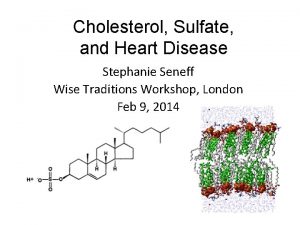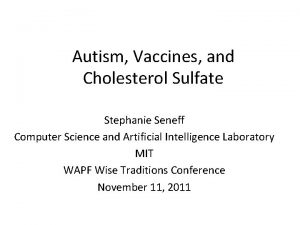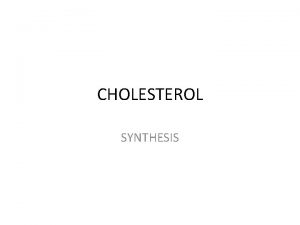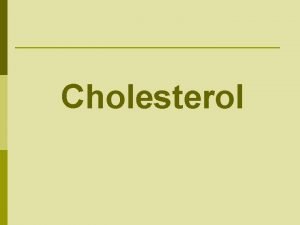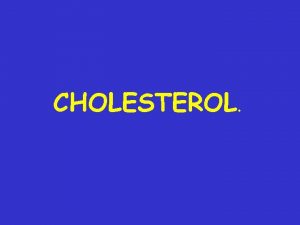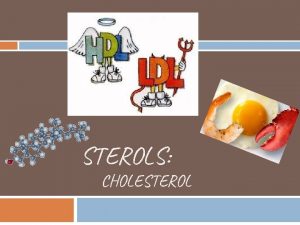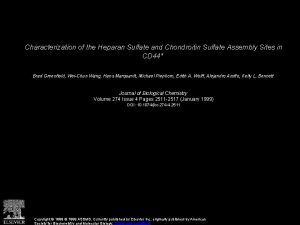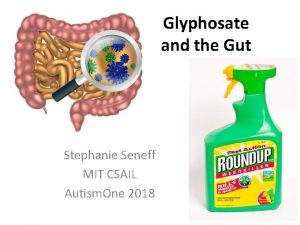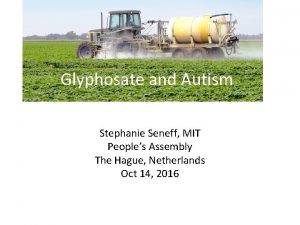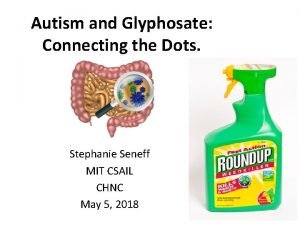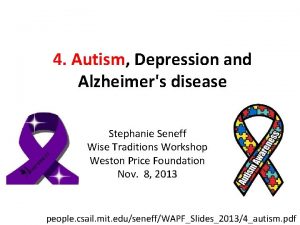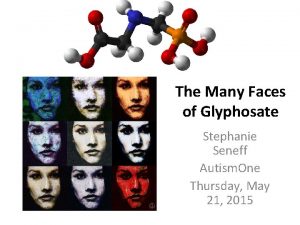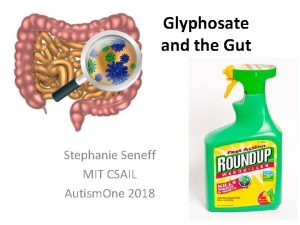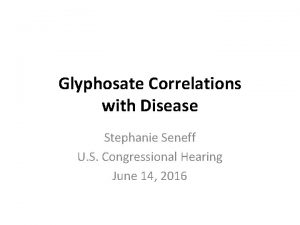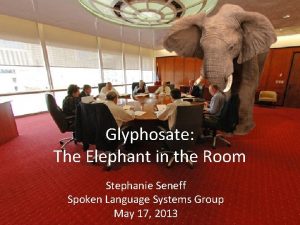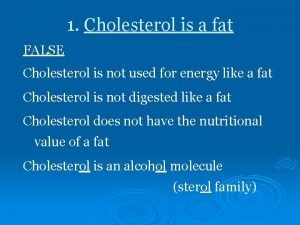2 Cholesterol Sulfate Stephanie Seneff Wise Traditions Workshop

































































































































- Slides: 129

2. Cholesterol Sulfate Stephanie Seneff Wise Traditions Workshop November 8, 2013 people. csail. mit. edu/seneff/WAPF_Slides_2013/2_cholesterol_sulfate. pdf

”If we all worked on the assumption that what is accepted as true is really true, there would be little hope of advance. " -- Orville Wright

Outline Introduction Cholesterol sulfate Heparan sulfate proteoglycans (HSPGs) Atherosclerosis is protective How statins really work explains why they don’t really work • Maintaining blood stability • Cancer to the rescue? • Summary • • •

Introduction

A Provocative Proposal • Cholesterol sulfate supplies oxygen, sulfur, cholesterol, energy and negative charge to all the tissues • Sulfate is synthesized from sulfide in skin and blood stream utilizing energy in sunlight – Protects from UV damage and keeps microbes out • Endothelial Nitric Oxide Synthase (e. NOS) performs the magic The skin is a solar powered battery!

Cholesterol and Cholesterol Sulfate Sulfation makes cholesterol watersoluble and therefore much easier to transport SULFATE

When cholesterol and sulfate “hold hands” they can navigate the waters together

Think about Sulfate! • Cells in the skin produce vitamin D 3 sulfate upon exposure to the sun – The precursor to vitamin D 3 is 7 -dehydrocholesterol • Cells also produce an abundance of cholesterol sulfate – I believe this is the more important molecule! • Many of the alleged benefits of vitamin D 3 are actually benefits of cholesterol sulfate – Protection against cancer, diabetes and cardiovascular disease; improved immune function

Heart Disease Mortality and Sunlight* *Grimes et al. , Q. J. Med. 1996; 89: 579 -589

Lack of Sunlight May Raise Stroke Risk* • Strokes are caused by blood instability: clots and hemorrhages – Is this due to insufficient sulfate in blood? • Study involved 16, 500 people • Tracked the history of where they had lived – Looked at weather statistics for those places • Found 60% increased risk to stroke for lowest sun exposure (relationship with both latitude and weather patterns) *A. Mozes, Health. Day, RSS Feed, Feb 2, 2012.

Ultraviolet Exposure and Mortality among Women in Sweden* • 38, 472 women selected in 1992, aged 30 -49 1991 - – monitored for 15 years • Questionnaire asked about frequency of sunbathing vacations and sunburn – Increased sunburn frequency associated with reduced all-cause mortality – Sunbathing vacations more than once a year reduced risk to cardiovascular disease and mortality * Yang et al. , Cancer Epidemiol Biomarkers Prev. 20(4): 683 -690, 2011

Skin Melanoma Increasing 2%/Yr since 1974* This corresponds to a 30 -fold increase in the use of sunscreen * Andrew Schneider, Aol News, May 24, 2010 aolnews. com/2010/05/24/study-many-sunscreens-may-be-accelerating-cancer

How to Stay Healthy • Plenty of dietary sulfur • Plenty of dietary cholesterol • Plenty of sun exposure

Cholesterol Sulfate

Cholesterol is a Miracle Worker • In the brain: – Synapse: promotes cell-cell communication – Myelin sheath: insulates channel from signal loss • In the membranes of all cells – Prevents ion leaks – Protects from pathogens (microbes) • In the plasma lipoprotein (LDL, HDL) – Essential for protecting contents from oxidation and glycation damage during transport to cells • Precursor to vital hormones – Vitamin D – All the sex hormones (testosterone, estrogen, etc. ) – Cortisone: the stress hormone • Aids in digestion of fats

Cholesterol is Essential for Insulin Release * • Experiment with pancreatic beta cells • Expose them to toxin that impairs cholesterol synthesis • Cells secrete significantly less insulin in response to glucose challenge * Xia et al. , Endocrinology 149: 10, 5136 -5145, 2008.

Cholesterol is Essential for Insulin Release * • Experiment with pancreatic beta cells • Expose them to toxin that impairs cholesterol This is one reason why statin drugs synthesis increase risk to diabetes • Cells secrete significantly less insulin in response to glucose challenge * Xia et al. , Endocrinology 149: 10, 5136 -5145, 2008.

Sulfate is Vastly Underappreciated! • Sulfate is the 4 th most abundant anion in the blood and protects it from coagulating • Detoxifies drugs, food additives, and environmental toxins like aluminum and mercury • Essential component of extracellular matrix proteins throughout the tissues • Cerebroside sulfate is a major constituent of meylin sheaths surrounding axons in neurons

Cholesterol Sulfate Deficiency • Cholesterol sulfate deficiency leads to filaggrin deficiency which is associated with: – Atopic Dermatitis – Eosinophilic Esophagitis – Asthma • These three conditions are on the rise and are associated with autism and celiac disease

Cholesterol Sulfate Synthesis in the Skin • Keratinocytes synthesize abundant cholesterol sulfate as they mature – This synthesis takes place in outer layer of the epidermis the • Cholesterol sulfate catalyzes synthesis of profilaggrin, one of the two key proteins forming the cross-linked mesh that protects from bacterial invasion and prevents water loss

Impaired wound healing in atopic dermatitis • Water loss • Microbe penetration *J. A. Segre, J Clin Invest. 2006; 116: 1150 -58

Filaggrin Plays a Crucial Role • Loss of filaggrin function associated with – Increased skin permeability – Susceptibility to eczema and asthma – Eosinophilic Esophagitis: (Eo. E)* * Schroeder et al. , Expert Rev clin Immunol. 6: 6, 929 -937, 2010.

EOE: A Modern Disease* • Allergic inflammatory condition of the esophagus • Eosinophils invade esophagus - Release toxins that kill viruses and induce tissue damage • Person has difficulty swallowing - Eats very slowly • Food gets stuck in the throat * Schroeder et al. , Expert Rev clin Immunol. 6: 6, 929 -937, 2010.

A Very Bad Idea

Cholesterol Sulfate in the Lungs* Bronchial tubes produce cholesterol sulfate in the epithelial cells as they mature and form the outer layer of the bronchial epithelium * Rearick et al. , J. Cell. Physiol. 133: 3, 573 -578, Dec. 1987.

Cholesterol Sulfate in Horses’ Hoofs! * • 37 -43% cholesterol • 15 -20% cholesterol sulfate *P. W. Wertz and P. T. Downing, J Lipid Res 25, 1985, 1320 -1323.

Laminitis (Founder) • Lameness in horses due to inflammation in the hoof • Can be caused by exposure to herbicides and nitrate fertilizers Is This due to Impaired Cholesterol Sulfate Supply to the Hoof?

Cholesterol Sulfate and Trypsin* • Trypsin is an enzyme released by the pancreas, which digests proteins • Too much trypsin leads to breakdown of collagen glue that maintains structural integrity of intestinal mucosa (GAGs) • Cholesterol sulfate suppresses trypsin synthesis (protects mucosa from breakdown) * Ito et al, J. Biochem. 123, 107 -114, 1998.

Cholesterol Sulfate Inhibits Trypsin * * Sato et al. , J. Investigative Dermatology, 11: 2, 189 -193, Aug 1998

Recapitulation • Cholesterol sulfate plays many important roles in the body: skin, blood, esophagus, lungs, and pancreas • Cholesterol sulfate in the skin and lungs keeps bacteria out and water in • Horses’ hooves are loaded with cholesterol sulfate • Cholesterol sulfate protects collagen from breakdown by trypsin

Heparan Sulfate Proteoglycans (HSPGs)

Sulfated Biomolecules* • • Sulfated mucopolysaccharides (glycosaminoglycans) Steroid sulfates Phenol sulfates Tyrosine sulfation Bilirubin sulfate Arylamine sulfates Choline sulfate in lichens, fungi and marine algae Sulfolipids *IH Goldberg, The sulfolipids. J. Lipi Res. Apr. 1961, 2(2), 103 -109.

Sulfated Biomolecules* • • Sulfated mucopolysaccharides (glycosaminoglycans) Steroid sulfates Phenol sulfates Tyrosine sulfation Bilirubin sulfate Arylamine sulfates Choline sulfate in lichens, fungi and marine algae Sulfolipids *IH Goldberg, The sulfolipids. J. Lipi Res. Apr. 1961, 2(2), 103 -109.

Sulfated Glycosaminoglycans (GAGs) • Prominent in extracellular matrix of all cells • Amount of sulfate depends on availability • Crucial for maintaining negative charge and protecting from infection http: //www. science-autism. org/sulphate. htm

Sulfated Glycosaminoglycans (GAGs) • Prominent in extracellular matrix of all cells • Amount of sulfate depends on availability. These are also known as • Crucial for“mucopolysaccharides” maintaining negative charge and protecting from infection http: //www. science-autism. org/sulphate. htm

Ten Positive Effects of Mucopolysaccharides * A lipid-clearing effect in the blood. Stimulation of cellular metabolism. Efficient metabolism of fatty acids. Increase in RNA and DNA synthesis of cells. Increase in growth, size and quantity of normal cells. Anti-atherosclerosis, anti-atherogenic activities. Anti-inflammatory effect. Anti-thrombogenic and anti-coagulant activity. Increases the number of coronary artery branches and collateral circulation in experimental atherosclerosis. • Accelerates healing, regeneration and repair of cardiovascular tissue • • • * http: //www. vitaflex. com/res_csaa. php

Ten Positive Effects of Mucopolysaccharides * A lipid-clearing effect in the blood. Stimulation of cellular metabolism. Efficient metabolism of fatty acids. Increase in RNA and DNA synthesis of cells. Increase Many in growth, andeffects quantity can of normal of size these be cells. Anti-atherosclerosis, anti-atherogenic activities. explained Anti-inflammatory effect. by the fact that they supply sulfate Anti-thrombogenic and anti-coagulant activity. Increases the number of coronary artery branches and collateral circulation in experimental atherosclerosis. • Accelerates healing, regeneration and repair of cardiovascular tissue • • • * http: //www. vitaflex. com/res_csaa. php

Heparan Sulfate: Wonder Worker Polymers of sugars with attached nitrogen and sulfates: safe glucose storage

Heparan Sulfate in Pancreas * • Beta cells in pancreas produce insulin Inflammatory • They also produce an abundance cells of heparan sulfate Heparan Insulin sulfate • In type I diabetes, inflammatory cells break down basement membrane and penetrate pancreatic islets • These inflammatory cells produce heparanase, which destroys heparan sulfate • This leads to cell death of beta cells and diabetes * Ziolkowski et al. , J Clin Invest. 122(1): 132– 141, Jan 2012.

Heparan Sulfate in Pancreas * • Beta cells in pancreas produce insulin Inflammatory • They also produce an abundance cells of heparan sulfate Heparan Insulin sulfate • Heparan In type I diabetes, Sulfateinflammatory is Essentialcells to Proper Function breakof down basement membrane Beta Cells and Insulin Production and penetrate pancreatic islets • These inflammatory cells produce heparanase, which destroys heparan sulfate • This leads to cell death of beta cells and diabetes * Ziolkowski et al. , J Clin Invest. 122(1): 132– 141, Jan 2012.

Various Factors that Increase Sulfate* An increase of the 35 S-sulfate deposit is effected regularly by infections, by injections of toxins and proteins, by hypoxemia, dietetic influence, muscular over-exertion, weather influence and increase of the blood pressure. SMPS= Sulfated mucopolysaccharides *Report by Bernhard Muschlien SMPS = Sulfated mucopolysaccharides = glycosaminoglycans First published in the German language in the SANUM-Post magazine (17/ 1991)

A Provocative Hypothesis Cells store glucose temporarily in HSPGs, protected by sulfate When cholesterol and sulfate are in short supply, storage of sugars in HSPGs becomes impaired This is the source of insulin resistance and diabetes!

Disrupted Signaling when HSPGs are Depleted* HPGs = Heparan Sulfate Proteoglycans *Figure 5 in P Muller and AF Schier, Developmental Cell 21, July 19, 2011, 145 -158.

Sulfotransferases (Transfer sulfate from one molecule to another) • • Carbohydrate sulfotransferase Galactose-3 -O-sulfotransferase Heparan sulfate sulfotransferases (2 -O, 3 -O, 6 -O) N-deacetylase/N-sulfotransferase Tyrosylprotein sulfotransferase Uronyl-2 -sulfotransferase Estrone sulfotransferase Chondroitin 4 -sulfotransferase

Recapitulation • Heparan sulfate proteoglycans (HSPGs) are everywhere in the body – They play a crucial role in ion transport, nutrient uptake, and cell signalling – They protect pancreas during insulin production • I propose that they also provide a temporary storage depot for glucose – Deficient sulfate leads to diabetes • Multiple sulfotransferases attest to the importance of sulfate to the body

Atherosclerosis is Protective!

End Stage Kidney Disease and Cardiovascular Disease* • • • Dialysis patients have extreme risk to cardiovascular disease High serum cholesterol High blood pressure High serum homocysteine Obesity Abnormally low Abnormally Emaciated low blood cholesterol pressure homocysteine Inflammation * Kalantar-Zadeh et al. , American Journal of Kidney Diseases 42: 5 864 -881, 2003

My Conclusion from This Inflammation is the ONLY “Risk Factor” that counts: All the other “Risk Factors” are protective measures!

Sulfates in the Kidneys* Glucose Glutamine *K. -I. Nagai et al. , Proc Jpn Acad Ser B Phys Biol Sci. 2008 January; 84(1): 24– 29

Statins and Kidney Failure* • Kidney failure is alarmingly on the rise in the US and elsewhere – Associated with a 23 -fold increase in risk to heart disease! • Statins are being overprescribed for patients with kidney failure – Severe muscle pain & rhabdomyolysis – Increased risk to dementia and diabetes – No improvement in kidney function * M. A. Lanaspa et al. , Nature Communications, 2013; Aug 24. [Epub ahead of print]

Heart Disease: A Theory! Cardiovascular plaque develops as an alternative mechanism to produce cholesterol sulfate from damaged LDL and homocysteine

A Recent Paper S. Seneff, A. Lauritzen, R. Davidson, and L. Lentz-Marino. “Is Endothelial Nitric Oxide Synthase a Moonlighting Protein Whose Day Job is Cholesterol Sulfate Synthesis? Implications for Cholesterol Transport, Diabetes and Cardiovascular Disease. ” Entropy 2012, 14, 2492 -2530.

What Happens when Cholesterol Sulfate Synthesis is Impaired? ? Cardiovascular disease!!! Activities in Plaque Produce Cholesterol Sulfate to Supply the Heart!

They Knew a Long Time Ago* • Article published in 1960 • Fed cholesterol to monkeys – induced atherosclerosis • If sulfur-containing nutrients are added, atherosclerosis is prevented • These nutrients provide source of sulfate to enable cholesterol transport * G. V. Mann et al. , Am. J. Clin. Nutr. 8, 491 -497, 1960.

They Knew a Long Time Ago* • Article in 1960 disease resembling "A published form of vascular • Fed cholesterol to monkeys human atherosclerosis has been produced in –the induced New atherosclerosis World primate Cebus fatuella. . In • If sulfur-containing order to producenutrients these phenomena, the arediets added, is hadatherosclerosis to be rich in cholesterol, choline prevented and neutral fat but relatively low in organic • These provide sulfurnutrients compounds. Without this deprivation source of sulfate to enable of organic sulfur the response of the serum cholesterol transport lipids to cholesterol feeding was small. " * G. V. Mann et al. , Am. J. Clin. Nutr. 8, 491 -497, 1960.

“Heart Stents Still Overused, Experts Say”* • Two misconceptions – Heart attack caused by blocked artery – Eating fatty foods induces fat build-up • Heart attack is actually caused by thrombus formation (blood clot) that often occurs in a region of the artery where plaque is not obstructive • Stent insertion is expensive and is not living up to the promise of protection *Anahad O’Connor, NY Times, Aug. 16, 2013

Steps in Atherosclerosis* 1. Inflamed endothelium provides adhesion molecules to trap and hold macrophages 2. Macrophages through scavenger process take up oxidized LDL and become foam cells 3. Interleukins and growth factors promote proliferation of smooth muscle cells (artery thickening) 4. Extracellular matrix proteins are degraded 5. Vulnerable plaque eruption: thrombosis * Libby et al. , Circulation 105: 1135 -1143, 2002

Cardiovascular Plaque* *Figure 3 in L. Badimo n et al. , Rev Esp Cardiol. 2009; 62(10): 1161 -78 (p. 1163)

Many Good Reasons for ROS • ROS (reactive oxygen species) are a key component of inflammation in the artery • ROS are needed to produce sulfate* • Oxidation of glycated LDL makes it accessible to macrophages for breakdown** • Peroxynitrite (product of reaction between superoxide and nitric oxide) is toxic to pathogens*** * Mitsuhashi et al. Shock 24(6) 529 -34, 2005. ** Kaplan and Aviram, Arterioscler Thromb Vasc Biol 21(3) 386 -93 2001. *** Alvarez et al. , J. Biol. Chem. 286, 6627 -6640, 2011.

Macrophages and Cholesterol* • Macrophages in artery wall take up oxidized LDL and export extracted cholesterol to HDL-A 1 • Macrophages eventually become damaged by exposure to oxidizing and glycating agents necrotic core * Wang and Oram, J. Biol. Chem. 277 (7) , 5692– 5697, 2002

Macrophage Proliferation in Plaque* *Figure 4, C. S. Robbins et al. , Nature Medicine, Aug. 2013 [e. Pub ahead of print]

Declaring War on Macrophages* • Macrophages replicate inside plaque – Suppressing their entry into plaque is not enough! • Proposal: develop new therapy that suppresses proliferation of macrophages in plaque "It's a bit like killing off the army to be sure there's no collateral damage when invaders attack your country” --David Diamond, Member of THINCs *C. S. Robbins et al. , Nature Medicine, Aug. 2013 [e. Pub ahead of print]

Elevated Homocysteine and Heart Disease* • 587 patients with coronary artery disease followed over median period of 4. 6 years • Homocysteine > 15 micromol/Liter 6. 5 -fold increase in death rate compared to homocysteine < 10 micromol/L *P. O. Lim et al. , Journal of Human Hypertension (2002) 16, 411– 415.

Pathway from Homocysteine to Sulfate* Vitamin A homocysteine thiolactone Superoxide: Reactive oxygen species (ROS) alpha keto butyrate When folate and B 12 are deficient, nearly all homocysteine is converted to homocysteine thiolactone thioretinamide Vitamin C sulfite retinoic acid Sulfite oxidase PAPS sulfate *Mc. Cully, Annals of Clinical and Laboratory Science 41: 4, 300 -313, 2011

Platelets and Cholesterol Sulfate* • Platelets and RBCs both synthesize cholesterol sulfate (Ch-S) – Ch-S is present in the atherosclerotic lesions in the aorta – Platelets will accept cholesterol only from HDL-A 1 – Platelet synthesis rate increases 300 -fold when PAPS is available. – PAPS is formed from ATP and sulfate • Platelet aggregation leads to thrombosis – HDL suppresses aggregation; LDL promotes it * Yanai et al, Circulation 109, 92 -96, 2004

Steps in Atherosclerosis: Reinterpreted 1. Endothelial cells lining artery walls feeding the heart release inflammatory agents 2. Macrophages infiltrate artery wall 3. Macrophages extract cholesterol from oxidized LDL and deliver it to HDL-A 1. 4. Platelets extract cholesterol from HLD-A 1 and convert it to cholesterol sulfate, with help from PAPS 5. Macrophages die and build up necrotic core

Putting it All Together homocysteine Synthesize sulfate Heart muscle cell sulfate ATP PAPS Red Blood Cell RBC insulin Platelet (3) Lipid Raft Cholesterol Sulfate glucose HDL-A 1 macrophage Ch Artery Wall Ch Apo. E ox. LDL ROS Inflammatory Agents Endothelial Cell

Putting it All Together homocysteine Synthesize sulfate Heart muscle cell sulfate ATP PAPS Red Blood Cell Lipid Raft Cholesterol protects the heart from Cholesterol RBC ion leaks and. Sulfate sulfate allows it insulin to. Platelet safely metabolizeglucose (3) HDL-A 1 macrophage Ch Artery Wall Ch Apo. E ox. LDL ROS Inflammatory Agents Endothelial Cell

Statins Increase Plaque Calcification* • 6673 people studied (2413 on statins 4260 not on statins) • Mean age 59, 55% male • Evaluated using coronary CT angiography noninvasive method to visualize atherosclerotic features • Statin use was associated with increased prevalence of calcified plaque and increasing numbers of coronary segments possessing calcified plaque *R. Nakazato et al. Atherosclerosis 225(1), 148 -153, November 2012.

I hypothesize that treatments aimed at reducing the supply of cholesterol to the plaque will eventually lead to severe deficiencies in cholesterol and sulfate supply to the heart, resulting in heart failure.

Congestive Heart Failure Post-statins Pre-statins National Heart, Lung, and Blood Institute National Institutes of Health Data Fact Sheet

Recapitulation • Kidney disease is associated with inversion of factors for heart disease risk – Kidneys depend critically on sulfates for function – Inflammation is required to synthesize sulfate • Cardiovascular disease can be best characterized as a factory to supply cholesterol and sulfate to the heart and kidney • Statin drugs, through their ability to deplete the supply of cholesterol to the plaque, can lead to heart failure and kidney failure down the road

How Statins Really Work Explains Why They Don’t Really Work

Sugar: The Bitter Truth* • Robert Lustig, UCSF Professor of Pediatrics, has done more than anyone to promote the idea that fructose is damaging to your health • In his 90 -minute lecture, he discusses the critical role that the liver plays in detoxifying fructose • Nearly 4 million views from You. Tube * http: //uctv. tv/search-details. aspx? show. ID=16717

Liver Detoxifies Fructose LDL (fats) Fructose • • Dietary fructose is toxic -- a severe glycating agent Liver takes up fructose and turns it into fat Fat is exported to tissues packaged in LDL particles Cholesterol is required to “wrap” synthesized fats

A Proposal • Statins prevent liver from detoxifying fructose • Muscles (type-II fibers) aggressively convert dietary sugars to lactate instead * • Muscles experience severe glycation damage • Cells die and release their contents as debris • Insufficient clean-up by macrophages leads to collateral damage • Fructose and glucose build up and cause widespread glycation damage • Cascade effect * G. de Pinieux et al. , Br J Clin Pharmacol 42: 333– 337, 1996

How Statins Change Fructose Metabolism LDL (fats) Statins Lactate sugars • Liver can’t come up with enough cholesterol to “wrap” synthesized fats with LDL • Muscle cells must dispose of sugars via anaerobic metabolism (convert to lactate) • Heart and liver benefit from a healthy fuel source

But, …The Muscle Cells Get Wrecked* • Patients on statins routinely get creatine phosphokinase levels monitored for possible muscle damage • However, even when creatine phosphokinase levels are not elevated, myopathy (muscle weakness) can occur, and is often associated with muscle damage • Patients on statins are often advised to continue statin therapy in this circumstance – This is bad advice * Mohaupt et al. , CMAJ 181(1 -2), E 11 -E 18, Jul 2009

Mitochondrial Disruption by Statins Depleted by Statins Cell is Forced to Switch to Anaerobic Metabolism Slide adapted from Statins and Miofibrillar Response, R. Laforge

Widespread glycation and ROS damage in muscle cells kills them BUT They don’t die properly!

Cytotoxic T-cells initiate apoptosis cascade and clean up cell debris following programmed cell death mediated by Fas-Fas. L signaling* * See: L. M. Blanco-Colio et al. , Circulation 108: 1506 -1503, 2003

Cell Apoptosis • Both Fas and Fas. L must migrate from the cytoplasm to the membrane to be activated • This requires isoprenylation by geranyl pyrophosphate • Statins suppress these mechanisms Fas Impaired Muscle Fiber Fas. L T-cell – Cell dies through necrosis instead * See: L. M. Blanco-Colio et al. , Circulation 108: 1506 -1503, 2003

memory problems fructose cataracts Heart failure lactate Kidney failure liver failure Glycation Damage AGEs diabetes

memory problems fructose cataracts Heart failure lactate Statins make you grow old faster Kidney failure liver failure Glycation Damage AGEs diabetes

Statins, Diabetes, and Cataracts* • Large study: 6397 patients • Divided into four groups: ±diabetes, ±statins • Looked at 50% point for age of diagnosis of cataracts • Taking a statin gives you cataracts three years earlier No diabetes With diabetes Age: No statins 57. 3 55. 1 Age: With statins 54. 9 51. 7 * C. M. Machan et al, Optom Vis Sci. 2012 Aug; 89(8): 1165 -71.

Statins Promote Muscle Fiber Atrophy* • Statins induce synthesis of atrogin-1 in muscles, inducing skeletal muscle atrophy • In controlled experiments, Lovastatin promoted muscle fiber damage in zebrafish embryos *J. -I. Hanai, et al. , J. Clini Invest. 117(12) 2007, 3940 -3951.

Myopathy, Weakness and Chondroitin Sulfate* • Chondroitin sulfate deficiency in muscles leads to severe limb and respiratory weakness • Prednisone (a synthetic corticosteroid) produced a marked increase in strength Hypothesis: prednisone sulfate supplies sulfate to synthesize chondroitin sulfate *M. T. al-Lozi et al. , Neurology. 1998 Feb; 50(2): 526 -9.

Heparin prevents Oxidative Damage from Fenton Reaction* • Superoxide (02 -) is a key ROS in the mitochondria – Iron oxidation (Fenton reaction) induces superoxide – Fe(II) + 02 + 20 H Fe(III)(OH) 2+ + 02 superoxide • Heparin (many sulfates) induces acidic environment that changes the reaction as follows: – 4 Fe(II) + 02 + 4 H+ 4 Fe(III) + 2 H 20 water – This produces water (harmless) rather than superoxide (destructive) *M. A. Ross et al. , Biochem. J. 1992, 286, 717 -720.

“Chronic and age-related increases in ROS production will cause mitochondrial damage and dysfunction that perpetuate a catastrophic cycle of cellular injury, further ROS generation, mitochondrial decline, and cell death. ”* . * S. W. Ballinger et al. , Circ Res. 2000; 86. P. 965

Lactate and Heart Failure* • Plasma lactate levels at rest are a marker for oxidative capacity • Study involving 10, 000 participants – Resting lactate levels measured – Monitored for ten years subsequently • Lactate levels grouped into quartiles – Highest quartile had significant increased incidence of heart failure and death *K. Matsushita et al. , Am J Epidemiol. 2013 Jun 30. [Epub ahead of print].

Recapitulation • Liver normally detoxifies fructose by converting it to fat LDL – Statins impair this process • Muscle cells respond by converting fructose to lactate – Supplies alternative fuel to liver, heart, and brain – But muscles suffer glycation damage as a consequence • Statins interfere with distressed muscle cell's ability to signal distress – Cell dies an unnatural rather than a programmed cell death – Fructose accumulates and causes widespread glycation • This has widespread consequences, including heart failure • Cataracts, a sign of AGEing, happen sooner on statins

Maintaining Blood Stability

The Glycocalyx • Negatively charged gel-like mesh lining the walls of all arteries, veins and capillaries • Depends crucially on sulfated polysaccharides – Particularly heparan sulfate proteoglycans (HSPGs) • Sulfate creates “exclusion zones” – Helps protect cells in wall from ion leaks and contact with enzymes suspended in blood – Greatly reduces amount of flowing blood (decreases resistance, lowers blood pressure) – Stores energy in “battery” constructed from structured water


Dr. Mercola Interviews Dr. Gerald Pollack* • "The Fourth Phase of Water" = the Exclusion Zone (EZ) – – Profoundly excludes things, even small molecules H 3 O 2 instead of H 2 O -- negatively charged! Fills most of your cells and the extracellular tissues "polywater" - water as a polymer • Many experiments in Pollack’s laboratory confirm the existence of EZ water – A hydrophilic surface (sulfate!) will promote growth of EZ water upon exposure to infrared light – EZ water absorbs UV light (270 nm) and this builds charge! • Water flows in small diameter tubes and the flow rate increases upon exposure to sunlight – Could the same thing be happening in your capillaries? • Pressure, oxygen, light, and infrared energy all build EZ water *http: //articles. mercola. com/sites/articles/archive/2013/08/18/exclusion-zone-water. aspx

A Quote from Pollack’s Book* “And so it is with the exclusion zone. Order cannot persist without a continual supply of energy. The separated charges will slowly recombine, and order will give way to disorder. The exclusion zone’s outer reaches will wear thin like an eroding beach. ” – page 95, The Fourth Phase of Water Sunlight renews the exclusion zones throughout your body!

Therapeutic Value of Sauna Therapy (Infrared light)* • Impaired vascular function associated with hypertension, hyperlipidemia, diabetes, obesity • Sauna therapy ameliorates endothelial dysfunction and improves health – Increased e. NOS synthesis in aorta in animal experiments – Decreased body weight and body fat in obese subjects – Improved cardiac function in patients with heart failure • Infrared expands exclusion zones 4 -fold** *S. Biro et al. , Exp Biol Med (Maywood). 2003 Nov; 228(10): 1245 -9. **B. Chai et al. , J Phys Chem B. 2009 October 22; 113(42): 13953– 13958.

Effect of Radiant Energy on -Surface Water * Near “The main question, however, is where the energy for building these charged, lowentropy zones might come from. It is shown that radiant energy profoundly expands these zones in a reversible, wavelength-dependent manner. It appears that incident radiant energy may be stored in the water as entropy loss and charge separation. ” *B. Chai et al. , J Phys Chem B. 2009 October 22; 113(42): 13953– 13958.

Key Role for Sulfates • Sulfates decorate exterior of cell, e. g. , as heparan sulfate proteoglycans (HSPGs) or as cholesterol sulfate (Ch-S) • Sulfates carry negative charge and keep suspended cells from sticking together • Sulfates, as kosmotropes, create exclusion zone – gel-like environment to protect cell Cell

Zeta Potential • Zeta potential indicates degree of repulsion between similarly charged particles in a dispersion (e. g. , the blood) • High zeta potential confers stability – RBCs and platelets resist aggregation • Low zeta potential causes flocculation and coagulation (blood clot) • Proposal: a steady drop in zeta potential in the blood as we age is the source of many modern diseases

Grounding the Human Body Reduces Blood Viscosity* • Blood viscosity is strongly influenced by the surface charge on the suspended particles (like RBCs) • A higher repulsive surface charge increases spacing between RBCs, reduces clumping, lowers viscosity, and lowers peripheral resistance to flow (blood pressure) • Grounding transfers electrons from soil to the body – Increases zeta potential, lowers blood viscosity *G. Chevalier et al. , J Alternative and Complementary Medicine, 1– 9, 2012

Hypothesis • When blood becomes deficient in negative charge (sulfates), glycocalyx becomes unhealthy • Endothelial cells develop gaps that allow blood to seep into tissues • Blood clots are needed to plug the holes • Mistakes can lead to dangerous blockage – Deep vein thrombosis – Pulmonary thrombosis

Strokes are Happening at Younger Age* • Incidence of stroke is increasing among people under 55 years old • 959 patients followed through 2012 (aged 18 to 50 years at time of stroke) – Suffered from stroke between 1980 and 2010. – Compared with age-matched young adults without stroke • Stroke victims have higher risk of dying prematurely – 3. 4 -fold higher risk in the 40 - to 50 -year-old age group – 6. 4 fold higher risk in the 18 -29 year olds • Underlying vascular disease remains active throughout life? *L. C. Rutten-Jacobs et al. , JAMA. 2013 Mar 20; 309(11): 1136 -44.

"High Cholesterol Levels Are Associated with Improved Long-term Survival after Acute Ischemic Stroke"* • 190 stroke patients studied • Survival rates (P= 0. 0001): 3 -mo 100% 92% 1 -yr 98% 87% 5 -yr 84% 57% high-cholesterol group low-cholesterol group *I. Markaki et al. , Journal of Stroke and Cerebrovascular Diseases, 2013: 1 -7.

DHEA Provides Sulfate? * • In aging rats: – e. NOS expression is lowered – Response of vascular smooth muscle to nitric oxide is decreased – Weakened resistance to oxidative damage • DHEA supplement ameliorates these effects and delays aging process *S. Wu et al. , Gerontology 2007; 53: 234– 237.

Recapitulation • Sulfates in the glycocalyx maintain proper function of the artery wall and smooth flow of the blood • Gerald Pollack has revolutionized our understanding of water as a miracle molecule • Infrared light induces growth of exclusion zone • Grounding can improve blood stability by providing negative charge through currents from the ground • High cholesterol leads to longer survival following stroke • DHEA sulfate can improve aging vessels

Cancer to the Rescue?

“Cancer as a Metabolic Disease”* • Turns cancer theory upside down! • Impaired mitochondrial function leads to switch to aerobic glycolysis – Cancer cells convert glucose to lactate, producing a tiny amount of energy – Consume lots of glucose • Metabolic dysfunction precedes genetic mutations *T. N. Seyfried and L. M. Shelton, Nutrition and Metabolism 7: 7, 2010

“Cancer as a Metabolic Disease”* • Turns cancer theory upside down! • Impaired mitochondrial function leads to switch to aerobic glycolysis Tumor is a factory where damaging – Cancer cells convert glucose to lactate, producing (glycating) sugars are converted into a tiny amount of energy healthy fuel to supply to heart and brain – Consume lots of glucose • Metabolic dysfunction precedes genetic mutations *T. N. Seyfried and L. M. Shelton, Nutrition and Metabolism 7: 7, 2010

Breast Cancer Overtreatment* • 200, 000 Norwegian women followed over two consecutive 6 -year periods • Half received regular breast exams and mammograms, while the other half did not • Those receiving monitoring developed 22% more incidence of breast cancer • Researchers concluded that the control group had probably had as many cancers as the “treatment” group, but these cancers had resolved on their own! • Another possibility is that the radiation in the mammogram induced breast cancer *P. H. Zahl et al. , Arch Intern Med. 2008; 168(21): 2311 -2316.

“Heparan Sulfate and Heparanase as Modulators of Breast Cancer Progression”* • Heparanase is a potent tumor modulator due to its protumorigenic, proangiogenic, and prometastatic activities – Plays a role in bone metastasis • Heparanase breaks down heparin sulfate into fragments of 4 to 7 k. Da size • Heparinase is upregulated in all human sarcomas and carcinomas • Syndecan-1 shedding is an important step in tumor invasion and metastasis *A. M. Gomes et al. , Bio. Med Research International, 2013, article ID: 852093

“Heparan Sulfate and Heparanase as Modulators of Breast Cancer Progression”* • Heparanase is a potent tumor modulator due to its protumorigenic, proangiogenic, and prometastatic activities – Plays a role in bone metastasis the tumor providing • Heparanase. Isbreaks down heparin sulfate into heparan to the blood? fragments of 4 tosulfate 7 k. Da size • Heparinase is upregulated in all human sarcomas and carcinomas • Syndecan-1 shedding is an important step in tumor invasion and metastasis *A. M. Gomes et al. , Bio. Med Research International, 2013, article ID: 852093

Syndecan Shedding in Breast Cancer Figure 1 from Weinbaum et al. , Annu. Rev. Biomed. Eng. 2007. 9: 121– 67

Hydrolysis of Estrone Sulfate and Dehydroepiandrosterone (DHEA) Sulfate by MCF-7 Human Breast Cancer Cells* Breast cancer tumor cells break down estrone sulfate and DHEA sulfate in order to supply sulfate to the blood stream? ? *J. H. Mac. Indoe et al. , Endocrinology Sep 1, 1988, 123(3), 1281 -1287.

Curing Cancer Brings on Health Problems* “The rise in cancer survival in Britain is a ‘double -edged sword’ a charity has warned, because the NHS is ‘woefully unprepared’ to cope with the number of patients who go on to suffer longterm health problems. ” “… one in four survivors is left suffering longterm debilitating health conditions as a result of the disease, or the treatment for it. ” *http: //www. telegraph. co. uk/healthnews/10188236/ Rise-in-cancer-survival-is-a-double-edged-sword. html

Curing Cancer Brings on Health Problems, Cont’d* • Many cancer survivors suffer extreme pain up to five years after diagnosis • Women diagnosed with breast cancer are almost twice as likely to get heart failure • Men diagnosed with prostate cancer are more than twice as likely to get osteoporosis • Many treated for prostate cancer or bowel cancer suffer from incontinence *http: //www. telegraph. co. uk/healthnews/10188236/ Rise-in-cancer-survival-is-a-double-edged-sword. html

Chemotherapy for Breast Cancer* • Chemotherapy induces anemia • EPO (erythropoietin) sometimes given to induce RBC regeneration from bone marrow – This can lead to thrombosis (blood clots) • Alternative is blood transfusions to restore hemoglobin count These problems suggest that breast cancer is associated with unstable blood *http: //www. medpagetoday. com/Hematology. Oncology/Anemia/40536

Cognitive Decline and Breast Cancer* "Patients treated with hormonal therapy were five times more likely to exhibit cognitive decline as compared with a control group. Chemotherapy was not a significant predictor of cognitive decline. " Suppressed ability to synthesize estrone sulfate leads to widespread sulfate deficiency in the brain? *http: //www. medpagetoday. com/Meeting. Coverage/MBCS/41486 Rugo H, et al "Prospective study of cognitive function in women with early-stage breast cancer: Predictors of cognitive decline" BSC 2013.

Statins and Breast Cancer* • Population-based case-control study of breast cancer • 1, 068 cases compared to 902 controls • Current users of statins for 10 years or longer – 1. 83 -fold increased risk of invasive ductal carcinoma (accounts for 7 out of 10 cases in UK) – 1. 97 -fold increased risk of invasive lobular carcinoma (10 to 15% of cases) I hypothesize that this is because statins deplete cholesterol sulfate supply and disrupt sugar metabolism *J. A. Mc. Dougall et al. , Cancer Epidemiol Biomarkers Prev. 2013 Jul 5. (Epub ahead of print)

Cholesterol Sulfate in Prostate Cancer* “Remarkably, cholesterol sulfate … was observed exclusively in the cancerous tissue, enabling its clear identification” *Livia S. Eberlin et al. Anal Chem. 2010 May 1; 82(9): 3430– 3434.

"Hormone Use in Prostate Cancer May Harm Kidneys"* • Analysis included 10, 250 men, who were followed for an average of 4. 1 years • Androgen deprivation therapy (ADT) led to significantly increased risk of acute kidney injury in men being treated for prostate cancer – Hyperglycemia is a well established adverse effect of ADT, and this stresses the kidney Is this due to insufficient sulfate supply to the body? ? *Charles Bankhead, Med. Page Today, Jul 16, 2013

Statins and Prostate Cancer* • 388 prostate cancer cases compared to 1, 552 controls • Ever-use of any statin was associated with a significant 55% increased risk to prostate cancer – Highest cumulative dose group had 86% increased risk *CC Chang et al. , Prostate. 2011 Dec; 71(16): 1818 -24

Iclusig: A Drug that’s Failing* • Chemotherapy for leukemia • “Fatal and life-threatening heart attack, stroke, loss of blood flow to the extremities resulting in tissue death, and severe narrowing of blood vessels in the extremities, heart, and brain requiring urgent surgical procedures to restore blood flow” *http: //www. medpagetoday. com/Hematology. Oncology/Leukemia/42637

Cancer and Deep Vein Thrombosis* • Deep vein thrombosis is the second-leading cause of death among cancer patients (after infection) • Chemotherapy increases risk of thrombosis 6. 5 x Hypothesis: Removing the tumor removes the protective effect *Previtali et al. , “Risk Factors for Venous and Arterial Thrombosis”, Blood Transfusion 9: 120 -38, 2011

Colon Cancer Tumor Cells Synthesize Hydrogen Sulfide* • Hydrogen sulfide induces cell growth in tumor cells by promoting glycolysis and oxidative phosphorylation (breaking down glucose to produce ATP). • Hydrogen sulfide is produced by the enzyme Cystathionine-β-synthase (CBS) in these cells – It is upregulated in these cells and promotes their growth • Suppression of hydrogen sulfide synthesis is being proposed as a technique to kill the tumor The tumor is able to synthesize sulfate from hydrogen sulfide gas it produces? ? the * K. Modisa et al. , Nitric Oxide, 31(2), 1 Sept. 2013, p. S 50.

William Li: Can we eat to starve cancer? * • You can starve a tumor (prevent blood vessel growth) by eating certain foods that inhibit angiogenesis (blood vessel growth) • Natural inhibitors of angiogenesis: – Resveratrol (red grapes, wine); ellagic acid (strawberries) – Turmeric, garlic, glusoamine (sulfate) – Olive oil, tea, parsley, etc. (flavonoids) • Also protect from obesity All of these foods either contain sulfate transporters or contain sulfur or both *TED Talk: https: //www. youtube. com/watch? v=B 9 b. DZ 5 -z. Pt. Y

Recapitulation • Cancer is a metabolic disease – Cancers cells consume massive amounts of glucose and produce massive amounts of lactate • Treating cancer can lead to deteriorating health – Heart failure, extreme pain, osteoporosis, mental decline, anemia, deep vein thrombosis • Breast cancer and prostate cancer supply sulfated sterols to the body – These are essential to maintain healthy blood • Foods that promote sulfate synthesis and sulfate transport can cause tumor to shrink

Summary • Sunlight-catalyzed cholesterol sulfate synthesis in the skin is essential for long-term health – Heart disease is a compensatory mechanism to synthesize cholesterol sulfate • Heparan sulfate proteoglycans (HSPGs) are pervasive in the body, and sulfate depletion leads to diabetes, heart disease, and kidney disease • Statin drugs work by destroying skeletal muscles to provide lactate for the heart • Hemostasis depends on adequate sulfate in the blood • Cancer may develop as a strategy to both reduce blood sugar levels and produce sulfated sterols

What’s Next? Early afternoon (1: 30 p. m. – 3 p. m. ) 1. Gut Microbes: How They Help Us Out 2. Autism, Depression, and Alzheimer's Disease Late afternoon (3: 30 p. m. – 5 p. m. ) 1. Glyphosate: The Elephant in the Room 2. Nutrition: Facts and Fiction
 Stephanie seneff cholesterol
Stephanie seneff cholesterol Glyphosate in vaccines
Glyphosate in vaccines Stephenie seneff
Stephenie seneff He who walks with the wise grows wise
He who walks with the wise grows wise Berotec nebs
Berotec nebs Ag2scompound name
Ag2scompound name Baruim sulfate
Baruim sulfate Magnesium ion electrons
Magnesium ion electrons Example of surgical dusting powder
Example of surgical dusting powder Ammonium sulfate precipitation
Ammonium sulfate precipitation Protamine sulfate test
Protamine sulfate test Severe preeclampsia criteria
Severe preeclampsia criteria Acute fulminating preeclampsia
Acute fulminating preeclampsia Aluminum sulfate + calcium hydroxide
Aluminum sulfate + calcium hydroxide Normal cervical length
Normal cervical length Ammonium sulfate and sodium hydroxide reaction
Ammonium sulfate and sodium hydroxide reaction Copper sulfate and potassium iodide
Copper sulfate and potassium iodide Zinc and copper reaction
Zinc and copper reaction Mass of kclo3
Mass of kclo3 Al+h2so4
Al+h2so4 Anion test for sulfate
Anion test for sulfate Sulfate reducing bacteria
Sulfate reducing bacteria Side effects of magnesium sulfate in pregnancy
Side effects of magnesium sulfate in pregnancy What is a spectator ion
What is a spectator ion Cristal de sulfate de cuivre
Cristal de sulfate de cuivre Thorn apple crystals in urine
Thorn apple crystals in urine How to determine total cholesterol
How to determine total cholesterol Dr pepper pun
Dr pepper pun High cholesterol
High cholesterol Cell membrane function
Cell membrane function Taux normal cholesterol ldl femme
Taux normal cholesterol ldl femme Digestion of cholesterol
Digestion of cholesterol These are alcohols containing cppp nucleus
These are alcohols containing cppp nucleus Sex and cholesterol
Sex and cholesterol Isolation of cholesterol from egg yolk principle
Isolation of cholesterol from egg yolk principle Steroids and cholesterol
Steroids and cholesterol Choleterol
Choleterol Emily lundstrom
Emily lundstrom Cholaplex
Cholaplex Symcard cholesterol
Symcard cholesterol Cholesterol cislovani
Cholesterol cislovani Chylomicron
Chylomicron Cholesterol mmol/l chart
Cholesterol mmol/l chart Hydrolysis vs dehydration
Hydrolysis vs dehydration Cholesterol homeostasis
Cholesterol homeostasis Is cholesterol a lipid
Is cholesterol a lipid Biological significance of cholesterol
Biological significance of cholesterol Cholesterol treatment trialists collaboration
Cholesterol treatment trialists collaboration Hugh cholesterol
Hugh cholesterol Non polar molecules that include fats oils and cholesterol
Non polar molecules that include fats oils and cholesterol Cholesterol total
Cholesterol total A dietitian wishes to see if a person's cholesterol
A dietitian wishes to see if a person's cholesterol Good and bad cholesterol
Good and bad cholesterol What are triglycerides
What are triglycerides Ketone body synthesis
Ketone body synthesis Biochem
Biochem Cholesterol homeostasis
Cholesterol homeostasis Cholesterol esterification
Cholesterol esterification Structure of cholesterol
Structure of cholesterol Cholesterol définition
Cholesterol définition Steroid hormone lipid
Steroid hormone lipid A dietitian wishes to see if a person's cholesterol
A dietitian wishes to see if a person's cholesterol Good and bad cholesterol
Good and bad cholesterol Personal balance sheet
Personal balance sheet Stephanie olivas
Stephanie olivas Stephanie cashion wyoming
Stephanie cashion wyoming Osteonekroos
Osteonekroos Stephanie cashion,
Stephanie cashion, Stephanie wants to buy a tomato plants
Stephanie wants to buy a tomato plants Stephanie mansell
Stephanie mansell Machismo examples
Machismo examples Stephanie rhinesmith
Stephanie rhinesmith Om&e
Om&e Stephanie baumgart
Stephanie baumgart Stephanie barger
Stephanie barger Stephanie boris
Stephanie boris Stephanie bandura
Stephanie bandura Stephanie spielman osu
Stephanie spielman osu Stephanie millar
Stephanie millar Stephanie ingle
Stephanie ingle Dr mildred olivier
Dr mildred olivier Stephanie balaouras
Stephanie balaouras Stephanie ann archival
Stephanie ann archival Stéphanie dameron
Stéphanie dameron Wpi syringe pump
Wpi syringe pump Stephanie mingo for judge
Stephanie mingo for judge Stephanie debaro
Stephanie debaro Stephanie budd
Stephanie budd Stephanie shawn
Stephanie shawn Stephanie troiano
Stephanie troiano Stephanie dayan
Stephanie dayan Stephanie lanoue
Stephanie lanoue What does stephanie mean
What does stephanie mean Stephanie reiser
Stephanie reiser Stephanie baus
Stephanie baus Stephanie seavers
Stephanie seavers Stephanie vecchio
Stephanie vecchio Stephanie ciccarelli
Stephanie ciccarelli Stéphanie besnier
Stéphanie besnier Stephanie daria h
Stephanie daria h Stephanie gimenez
Stephanie gimenez Stephanie shumate
Stephanie shumate Stephanie nord
Stephanie nord Dworkin interpretivism
Dworkin interpretivism Stephanie stute
Stephanie stute Stephanie beauceron
Stephanie beauceron Chat and conferencing
Chat and conferencing Stephanie croft
Stephanie croft Stephanie cotton
Stephanie cotton Stephanie short nsf
Stephanie short nsf What did stephanie cromwell and elizabeth venko decide?
What did stephanie cromwell and elizabeth venko decide? Dr hahusseau stéphanie
Dr hahusseau stéphanie Stephanie justine
Stephanie justine Stephanie taft
Stephanie taft Dr stephanie reese
Dr stephanie reese Stephanie odom
Stephanie odom Stephanie sundberg
Stephanie sundberg Pughs tires
Pughs tires Stephanie gruber victoria
Stephanie gruber victoria Erwin giesing
Erwin giesing Stephanie tompkins
Stephanie tompkins Stephanie witherspoon
Stephanie witherspoon What does norman ask melinda
What does norman ask melinda Old nzvy
Old nzvy Stephanie jean philippe
Stephanie jean philippe Systemanalyse und programmentwicklung
Systemanalyse und programmentwicklung Stephanie carnes
Stephanie carnes Stephanie strove for a
Stephanie strove for a Stephanie cook model
Stephanie cook model Woody allen agoraphobia
Woody allen agoraphobia
